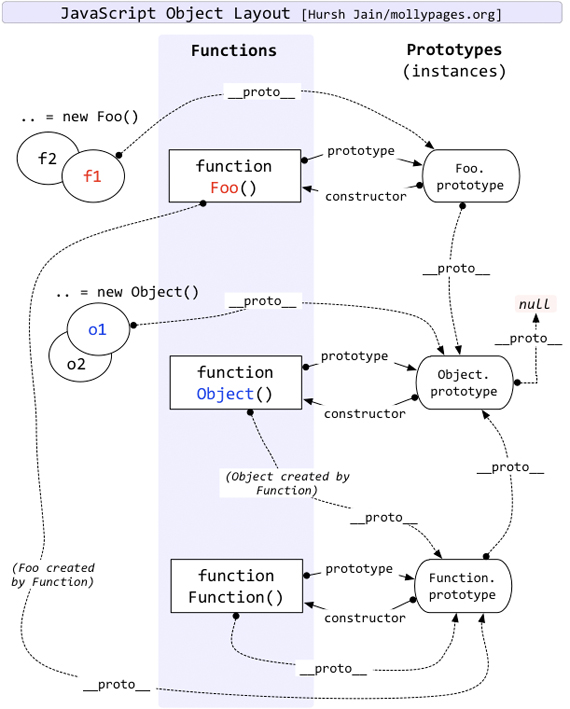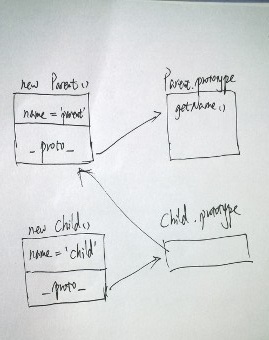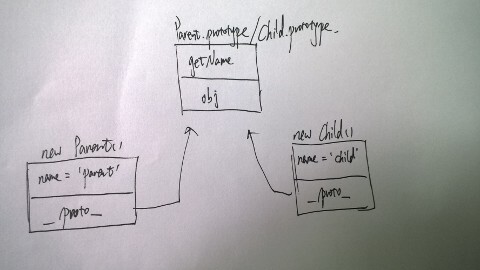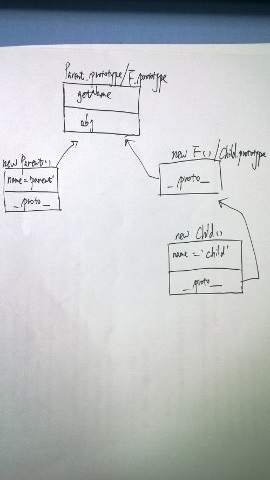真正意義上來說Javascript並不是一門面向對象的語言,沒有提供傳統的繼承方式,但是它提供了一種原型繼承的方式,利用自身提供的原型屬性來實現繼承。
原型與原型鏈
說原型繼承之前還是要先說說原型和原型鏈,畢竟這是實現原型繼承的基礎。
在Javascript中,每個函數都有一個原型屬性prototype指向自身的原型,而由這個函數創建的對象也有一個__proto__屬性指向這個原型,而函數的原型是一個對象,所以這個對象也會有一個__proto__指向自己的原型,這樣逐層深入直到Object對象的原型,這樣就形成了原型鏈。下面這張圖很好的解釋了Javascript中的原型和原型鏈的關系。

每個函數都是Function函數創建的對象,所以每個函數也有一個__proto__屬性指向Function函數的原型。這裡需要指出的是,真正形成原型鏈的是每個對象的__proto__屬性,而不是函數的prototype屬性,這是很重要的。
原型繼承
基本模式
復制代碼 代碼如下:
var Parent = function(){
this.name = 'parent' ;
} ;
Parent.prototype.getName = function(){
return this.name ;
} ;
Parent.prototype.obj = {a : 1} ;
var Child = function(){
this.name = 'child' ;
} ;
Child.prototype = new Parent() ;
var parent = new Parent() ;
var child = new Child() ;
console.log(parent.getName()) ; //parent
console.log(child.getName()) ; //child
這種是最簡單實現原型繼承的方法,直接把父類的對象賦值給子類構造函數的原型,這樣子類的對象就可以訪問到父類以及父類構造函數的prototype中的屬性。 這種方法的原型繼承圖如下:

這種方法的優點很明顯,實現十分簡單,不需要任何特殊的操作;同時缺點也很明顯,如果子類需要做跟父類構造函數中相同的初始化動作,那麼就得在子類構造函數中再重復一遍父類中的操作:
復制代碼 代碼如下:
var Parent = function(name){
this.name = name || 'parent' ;
} ;
Parent.prototype.getName = function(){
return this.name ;
} ;
Parent.prototype.obj = {a : 1} ;
var Child = function(name){
this.name = name || 'child' ;
} ;
Child.prototype = new Parent() ;
var parent = new Parent('myParent') ;
var child = new Child('myChild') ;
console.log(parent.getName()) ; //myParent
console.log(child.getName()) ; //myChild
上面這種情況還只是需要初始化name屬性,如果初始化工作不斷增加,這種方式是很不方便的。因此就有了下面一種改進的方式。
借用構造函數
復制代碼 代碼如下:
var Parent = function(name){
this.name = name || 'parent' ;
} ;
Parent.prototype.getName = function(){
return this.name ;
} ;
Parent.prototype.obj = {a : 1} ;
var Child = function(name){
Parent.apply(this,arguments) ;
} ;
Child.prototype = new Parent() ;
var parent = new Parent('myParent') ;
var child = new Child('myChild') ;
console.log(parent.getName()) ; //myParent
console.log(child.getName()) ; //myChild
上面這種方法在子類構造函數中通過apply調用父類的構造函數來進行相同的初始化工作,這樣不管父類中做了多少初始化工作,子類也可以執行同樣的初始化工作。但是上面這種實現還存在一個問題,父類構造函數被執行了兩次,一次是在子類構造函數中,一次在賦值子類原型時,這是很多余的,所以我們還需要做一個改進:
復制代碼 代碼如下:
var Parent = function(name){
this.name = name || 'parent' ;
} ;
Parent.prototype.getName = function(){
return this.name ;
} ;
Parent.prototype.obj = {a : 1} ;
var Child = function(name){
Parent.apply(this,arguments) ;
} ;
Child.prototype = Parent.prototype ;
var parent = new Parent('myParent') ;
var child = new Child('myChild') ;
console.log(parent.getName()) ; //myParent
console.log(child.getName()) ; //myChild
這樣我們就只需要在子類構造函數中執行一次父類的構造函數,同時又可以繼承父類原型中的屬性,這也比較符合原型的初衷,就是把需要復用的內容放在原型中,我們也只是繼承了原型中可復用的內容。上面這種方式的原型圖如下:

臨時構造函數模式(聖杯模式)
上面借用構造函數模式最後改進的版本還是存在問題,它把父類的原型直接賦值給子類的原型,這就會造成一個問題,就是如果對子類的原型做了修改,那麼這個修改同時也會影響到父類的原型,進而影響父類對象,這個肯定不是大家所希望看到的。為了解決這個問題就有了臨時構造函數模式。
復制代碼 代碼如下:
var Parent = function(name){
this.name = name || 'parent' ;
} ;
Parent.prototype.getName = function(){
return this.name ;
} ;
Parent.prototype.obj = {a : 1} ;
var Child = function(name){
Parent.apply(this,arguments) ;
} ;
var F = new Function(){} ;
F.prototype = Parent.prototype ;
Child.prototype = new F() ;
var parent = new Parent('myParent') ;
var child = new Child('myChild') ;
console.log(parent.getName()) ; //myParent
console.log(child.getName()) ; //myChild
該方法的原型繼承圖如下:

很容易可以看出,通過在父類原型和子類原型之間加入一個臨時的構造函數F,切斷了子類原型和父類原型之間的聯系,這樣當子類原型做修改時就不會影響到父類原型。
我的方法
《Javascript模式》中到聖杯模式就結束了,可是不管上面哪一種方法都有一個不容易被發現的問題。大家可以看到我在'Parent'的prototype屬性中加入了一個obj對象字面量屬性,但是一直都沒有用。我們在聖杯模式的基礎上來看看下面這種情況:
復制代碼 代碼如下:
var Parent = function(name){
this.name = name || 'parent' ;
} ;
Parent.prototype.getName = function(){
return this.name ;
} ;
Parent.prototype.obj = {a : 1} ;
var Child = function(name){
Parent.apply(this,arguments) ;
} ;
var F = new Function(){} ;
F.prototype = Parent.prototype ;
Child.prototype = new F() ;
var parent = new Parent('myParent') ;
var child = new Child('myChild') ;
console.log(child.obj.a) ; //1
console.log(parent.obj.a) ; //1
child.obj.a = 2 ;
console.log(child.obj.a) ; //2
console.log(parent.obj.a) ; //2
在上面這種情況中,當我修改child對象obj.a的時候,同時父類的原型中的obj.a也會被修改,這就發生了和共享原型同樣的問題。出現這個情況是因為當訪問child.obj.a的時候,我們會沿著原型鏈一直找到父類的prototype中,然後找到了obj屬性,然後對obj.a進行修改。再看看下面這種情況:
復制代碼 代碼如下:
var Parent = function(name){
this.name = name || 'parent' ;
} ;
Parent.prototype.getName = function(){
return this.name ;
} ;
Parent.prototype.obj = {a : 1} ;
var Child = function(name){
Parent.apply(this,arguments) ;
} ;
var F = new Function(){} ;
F.prototype = Parent.prototype ;
Child.prototype = new F() ;
var parent = new Parent('myParent') ;
var child = new Child('myChild') ;
console.log(child.obj.a) ; //1
console.log(parent.obj.a) ; //1
child.obj.a = 2 ;
console.log(child.obj.a) ; //2
console.log(parent.obj.a) ; //2
這裡有一個關鍵的問題,當對象訪問原型中的屬性時,原型中的屬性對於對象來說是只讀的,也就是說child對象可以讀取obj對象,但是無法修改原型中obj對象引用,所以當child修改obj的時候並不會對原型中的obj產生影響,它只是在自身對象添加了一個obj屬性,覆蓋了父類原型中的obj屬性。而當child對象修改obj.a時,它先讀取了原型中obj的引用,這時候child.obj和Parent.prototype.obj是指向同一個對象的,所以child對obj.a的修改會影響到Parent.prototype.obj.a的值,進而影響父類的對象。AngularJS中關於$scope嵌套的繼承方式就是模范Javasript中的原型繼承來實現的。
根據上面的描述,只要子類對象中訪問到的原型跟父類原型是同一個對象,那麼就會出現上面這種情況,所以我們可以對父類原型進行拷貝然後再賦值給子類原型,這樣當子類修改原型中的屬性時就只是修改父類原型的一個拷貝,並不會影響到父類原型。具體實現如下:
復制代碼 代碼如下:
var deepClone = function(source,target){
source = source || {} ;
var toStr = Object.prototype.toString ,
arrStr = '[object array]' ;
for(var i in source){
if(source.hasOwnProperty(i)){
var item = source[i] ;
if(typeof item === 'object'){
target[i] = (toStr.apply(item).toLowerCase() === arrStr) : [] ? {} ;
deepClone(item,target[i]) ;
}else{
deepClone(item,target[i]) ;
}
}
}
return target ;
} ;
var Parent = function(name){
this.name = name || 'parent' ;
} ;
Parent.prototype.getName = function(){
return this.name ;
} ;
Parent.prototype.obj = {a : '1'} ;
var Child = function(name){
Parent.apply(this,arguments) ;
} ;
Child.prototype = deepClone(Parent.prototype) ;
var child = new Child('child') ;
var parent = new Parent('parent') ;
console.log(child.obj.a) ; //1
console.log(parent.obj.a) ; //1
child.obj.a = '2' ;
console.log(child.obj.a) ; //2
console.log(parent.obj.a) ; //1
綜合上面所有的考慮,Javascript繼承的具體實現如下,這裡只考慮了Child和Parent都是函數的情況下:
復制代碼 代碼如下:
var deepClone = function(source,target){
source = source || {} ;
var toStr = Object.prototype.toString ,
arrStr = '[object array]' ;
for(var i in source){
if(source.hasOwnProperty(i)){
var item = source[i] ;
if(typeof item === 'object'){
target[i] = (toStr.apply(item).toLowerCase() === arrStr) : [] ? {} ;
deepClone(item,target[i]) ;
}else{
deepClone(item,target[i]) ;
}
}
}
return target ;
} ;
var extend = function(Parent,Child){
Child = Child || function(){} ;
if(Parent === undefined)
return Child ;
//借用父類構造函數
Child = function(){
Parent.apply(this,argument) ;
} ;
//通過深拷貝繼承父類原型
Child.prototype = deepClone(Parent.prototype) ;
//重置constructor屬性
Child.prototype.constructor = Child ;
} ;
總結
說了這麼多,其實Javascript中實現繼承是十分靈活多樣的,並沒有一種最好的方法,需要根據不同的需求實現不同方式的繼承,最重要的是要理解Javascript中實現繼承的原理,也就是原型和原型鏈的問題,只要理解了這些,自己實現繼承就可以游刃有余。